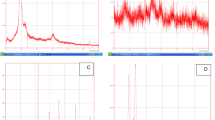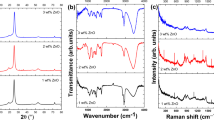Abstract
Polymer nanomaterials are an emanating area of research incited by the wide range of applications in solar cells, catalysis, sensors, drug delivery, electronics, bioimaging, etc., due to their outstanding mechanical, optical and electronic properties. Small dimensions in the nanometre range and a high surface-to-volume ratio of polymer nanomaterials possess distinctive features compared to bulk counterparts. In this work, doped polyvinyl alcohol (PVA) nanostructures were prepared by a one-step hydrothermal synthesis method and studied the morphological, structural and optical properties. The attained nanomaterials exhibit a spherical shape, and their average size was calculated as 3.98 nm by HR-TEM analysis. The obtained nanomaterials are dissolved in N,N-dimethyl formamide (DMF) solvent and can be employed for optoelectronic devices due to their amorphous structure and direct bandgap. Green luminescence was observed under UV light, and non-biocidal activity showed against Escherichia coli, Pseudomonas fluorescens, E. coli DH5α, Bacillus subtilis and Staphylococcus aureus.


Similar content being viewed by others
References
Anjaneyulu U, Priyadarshini B, Nirmala Grace A, Vijayalakshmi U (2017) Fabrication and characterization of Ag doped hydroxyapatite-polyvinyl alcohol composite nanofibers and its in vitro biological evaluations for bone tissue engineering applications. J Sol Gel Sci Technol 81:750–761
Aziz SB, Abidin ZHZ, Kadir MFZ (2015) Innovative method to avoid the reduction of silver ions to silver nanoparticles in silver ion conducting based polymer electrolytes. Phys Scr 90(3):35808
Aziz SB, Abdulwahid RT, Rsaul HA, Ahmed HM (2016) In situ synthesis of CuS nanoparticle with a distinguishable SPR peak in NIR region. J Mater Sci Mater Electron 27:4163–4171
Aziz SB, Marf AS, Dannoun EMA, Brza MA, Abdullah RM (2020) The study of the degree of crystallinity, electrical equivalent circuit, and dielectric properties of polyvinyl alcohol (PVA)-based biopolymer electrolytes. Polymers (basel) 12(10):2184
Bhattacharya DS, Bapat A, Svechkarev D, Mohs AM (2021) Water-soluble blue fluorescent non-conjugated polymer dots from hyaluronic acid and hydrophobic amino acids. ACS Omega 6(28):17890–17901
Chen Q, Wang E (2022) Length effects of flexible spacers in non-conjugated polymer acceptors on photovoltaic and mechanical properties of all-polymer solar cells. In: Proceedings of materials for sustainable development conference (MAT-SUS)(NFM22)
Dong Y, Lin J, Chen Y, Fu F, Chi Y, Chen G (2014) Graphene quantum dots, graphene oxide, carbon quantum dots and graphite nanocrystals in coals. Nanoscale 6(13):7410–7415
Fernandes RF, Paganoto GT, Temperini MLA (2021) Non-traditional intrinsic luminescence from non-conjugated polymer dots: designing a hybrid biomaterial. Polym Chem 12(43):6319–6328
Ghamsari MS (2021) Polymer nanomaterials in bioimaging. In: Advances in polymeric nanomaterials for biomedical applications. Elsevier, Amsterdam, pp. 161–189. https://doi.org/10.1016/B978-0-12-814657-6.00011-2
Joseph N, Mathew AA, Daniel EC, Balachandran M (2023) Polymer-carbon nanocomposite: synthesis, optical and biocidal properties. Results Chem 5:100826. https://doi.org/10.1016/j.rechem.2023.100826
Li C-H, Wang W-F, Stanislas N, Yang J-L (2022) Facile preparation of fluorescent water-soluble non-conjugated polymer dots and fabricating an acetylcholinesterase biosensor. RSC Adv 12(13):7911–7921
Makuła P, Pacia M, Macyk W (2018) How to correctly determine the band gap energy of modified semiconductor photocatalysts based on UV–Vis spectra. J Phys Chem Lett 9(23):6814–6817. https://doi.org/10.1021/acs.jpclett.8b02892
Mathew AA, Balachandran M (2023) A review on recent trends in biological applications of non-conjugated polymer dots. J Inorg Organomet Polym Mater 33(11):3340–3354
Mathew AA, Antony M, Thomas R, Sarojini S, Balachandran M (2022a) Fluorescent PVDF dots: from synthesis to biocidal activity. Polym Bull 1–18
Mathew AA, Joseph N, Daniel EC, Balachandran M (2022b) Facile synthesis of polymer dot and its antibacterial action against Staphylococcus aureus. In: International conference on nanotechnology: opportunities and challenges, 2022, pp 313–317
Mathew AA, Varghese M, Balachandran M (2023) Biosafety and toxicity evaluation of carbon nanomaterials. In: Carbon nanostructures in biomedical applications. Springer International Publishing, Cham, pp 363–398
Nasar G, Khan MS, Khalil U (2009) Structural study of PVA composites with inorganic salts by X-ray diffraction. J Pak Mater Soc 3(2):67
Omer KM, Hassan AQ (2017) Chelation-enhanced fluorescence of phosphorus doped carbon nanodots for multi-ion detection. Microchim Acta 184:2063–2071
Palani P, Karpagam S (2021) Conjugated polymers—a versatile platform for various photophysical, electrochemical and biomedical applications: a comprehensive review. New J Chem 45(41):19182–19209
Ru Y et al (2020) Recent advances in chiral carbonized polymer dots: from synthesis and properties to applications. Nano Today 34:100953
Saji M, Elsa Saji B, Joseph N, Mathew AA, Daniel EC, Balachandran M (2022) Investigation of fluorescence enhancement and antibacterial properties of nitrogen-doped carbonized polymer nanomaterials (N-CPNs). Int J Polym Anal Charact 27(7):464–476. https://doi.org/10.1080/1023666X.2022.2110122
Sheqnab ML, Alnayli RS (2019) Effect of Cdte nanoparticles on linear and nonlinear optical property of polyvinyl alcohols PVA film. J Coll Educ Pure Sci 9(2):259–268. https://doi.org/10.32792/utq.jceps.09.02.28
Shetty BG, Crasta V, Kumar NBR, Rajesh K, Bairy R (2019) Effect of nano fillers on electrical, mechanical, fluorescent and third order non linear optical properties of PVA. Mater Res Express 6(7):75055
Stepanidenko EA, Ushakova EV, Fedorov AV, Rogach AL (2021) Applications of carbon dots in optoelectronics. Nanomaterials 11(2):364
Tang Y, Zhou X, Xu K, Dong X (2020) One-pot synthesis of fluorescent non-conjugated polymer dots for Fe3+ detection and temperature sensing. Spectrochim Acta Part A Mol Biomol Spectrosc 240:118626
Thongchom C et al (2022) An experimental study on the effect of nanomaterials and fibers on the mechanical properties of polymer composites. Buildings 12(1):7. https://doi.org/10.3390/buildings12010007
Venkatesan RA, Joseph N, Balachandran M (2020) Green synthesis of reduced graphene nanostructure from Cinnamomum camphora. Lett Appl Nanobiosci 10:2003–2011
Verma M, Chan Y-H, Saha S, Liu M-H (2020) Recent developments in semiconducting polymer dots for analytical detection and NIR-II fluorescence imaging. ACS Appl Bio Mater 4(3):2142–2159
Wang R, Lu K-Q, Tang Z-R, Xu Y-J (2017) Recent progress in carbon quantum dots: synthesis, properties and applications in photocatalysis. J Mater Chem A 5(8):3717–3734
Witjaksono G et al (2021) Effect of nitrogen doping on the optical bandgap and electrical conductivity of nitrogen-doped reduced graphene oxide. Molecules 26(21):6424
Wu P, Li W, Wu Q, Liu Y, Liu S (2017) Hydrothermal synthesis of nitrogen-doped carbon quantum dots from microcrystalline cellulose for the detection of Fe 3+ ions in an acidic environment. RSC Adv 7(70):44144–44153
Zhang C et al (2022) Water-soluble non-conjugated polymer dots with strong green fluorescence for sensitive detection of organophosphate pesticides. Anal Chim Acta 1206:339792
Acknowledgements
The research work of Aleena Ann Mathew is funded by DST for their fellowship grants DST/INSPIRE/03/2021/000566 and Manoj Balachandran is thankful to DST for his major research fund DST/TMD/CERI/RES/ 2020.
Author information
Authors and Affiliations
Contributions
Conception, experimental design and manuscript composition: Aleena Ann Mathew and Neethu Joseph; carrying out antibacterial measurements: Elcey C Daniel; manuscript correction: Manoj Balachandran.
Corresponding author
Ethics declarations
Conflict of interest
There is no conflict of interest.
Ethical approval
I, Aleena Ann Mathew, hereby consciously assure that the following statements are fulfilled for the manuscript ‘Effect of Functionalization on the Optical Properties of Polymer-based Nanostructure’. 1. This material is the own original work of authors, which has not been formerly published elsewhere. The paper is not currently being considered for publication elsewhere.
Additional information
Publisher's Note
Springer Nature remains neutral with regard to jurisdictional claims in published maps and institutional affiliations.
Rights and permissions
Springer Nature or its licensor (e.g. a society or other partner) holds exclusive rights to this article under a publishing agreement with the author(s) or other rightsholder(s); author self-archiving of the accepted manuscript version of this article is solely governed by the terms of such publishing agreement and applicable law.
About this article
Cite this article
Mathew, A.A., Joseph, N., Daniel, E.C. et al. Effect of functionalization on the optical properties of polymer-based nanostructure. Appl Nanosci (2024). https://doi.org/10.1007/s13204-024-03045-y
Received:
Accepted:
Published:
DOI: https://doi.org/10.1007/s13204-024-03045-y




